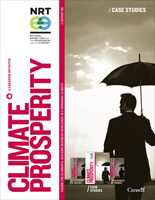Royal Bank of Canada – Case Study
FACING THE ELEMENTS: Building Business Resilience in a Changing Climate
AT A GLANCE // |
Location:Toronto, Ontario Industry:Finance and Insurance Employees (2011):74,000 Revenue (2010):C$27.7 billion |
Key adaptation
|
Adaptation
|
Business BenefitsImprovement of risk management and due diligence |
Business ChallengesUnderstanding how climate change interacts with other risks in relation to insurance |
COMPANY OVERVIEW //
TORONTO, ONTARIO
www.rbc.com

Royal Bank Plaza, Toronto
(photo credit: Royal Bank of Canada)
RBC operates five business segments: Canadian banking, wealth management, international banking, capital markets, and insurance. Canadian banking and wealth management account for 60 to 70% of RBC’s revenues.6
FINANCE AND INSURANCE IN A CHANGING CLIMATE
Climate change can give rise to credit risk for financial institutions that lend to climatically vulnerable businesses. For instance, credit worthiness may be reduced if climate change impacts decrease asset value and/or income for a particular client.
The banking sector will also face changing operational risks, such as the potential for disruptions to business continuity due to more frequent and severe weather events in certain geographies.
Climate change presents threats to various sectors and regions, and it may affect the long-term returns of investment portfolios specialized in one or a few sectors in locations predicted to be significantly exposed to changing climatic patterns. If climate risks are not integrated into investment analysis and portfolio management, investors may make uninformed and non-optimal investment decisions, contrary to the best interests of their fiduciaries. For example, they may invest in water-dependent companies in regions to be affected by more and longer drought events in the near- to mid-term, on the basis of good short-term cash flow projections, despite the possibility of future decreased output and increased costs.
A report by four institutional investors focusing on four climatically-sensitive investment sectors stated that “climate change is now recognized as one of the most serious long-term challenges facing the investment community.”7 Some institutional investors have taken notice of these potential impacts on corporate value and have supported shareholder resolutions encouraging companies to disclose or take into account climate change issues.8
Insurers are directly affected by climate change since they pay the bill for insured losses caused by weather-related perils, such as floods, storms, wildfires, etc. Weather-related losses have been increasing in the past 30 years globally and the predicted increase in severe weather events is expected to lead to higher insurance premiums and reduced available insurance coverage in exposed locations.9
DRIVERS
Overall, RBC considers that its vulnerability to climate change is low. RBC is for the most part a retail bank and, as such, deals with intangible goods.10 However the company has identified three risk areas that could be affected by climate change:
1 // CREDIT
Some industry sectors in some regions will be faced with challenges to resources availability, and may suffer more frequent and/or severe business interruption.
2 // INSURANCE
Property and casualty insurance is directly affected by adverse extreme weather.
2 // OPERATIONS Business continuity could be impacted by an increase in extreme weather events.
In a high-level climate risk assessment, RBC examined the potential physical impacts of climate change on the following sectors in its banking and investment portfolio: agriculture, fisheries, forestry, cement, tourism, property and casualty insurance, energy, and manufacturing. The study illustrated the magnitude and nature of physical impacts on sectors in different regions of North America. Because many of its clients have international operations, RBC is also exposed indirectly to climate risk in foreign markets.
A FOCUS ON CLIENT AND STAFF AWARENESS AND UNDERSTANDING
RBC has recognized in its Environmental Blueprint that climate change will pose considerable financial, environmental and social challenges in the future, and that the Canadian economy needs to start adapting. This publicly available document outlines the company’s objectives and policy with regards to sustainability, and it includes a series of objectives that relate to climate change:11
// Incorporate climate change into relevant policies and decision-making processes.
// Support transactions and business activities intending to facilitate adaptation to climate change.
// Participate in market-based initiatives that focus on promoting climate adaptation.
// Review the potential impacts of climate change on RCB’s insurance businesses.
In practice, RBC promotes climate resilience on two separate fronts: raising client and staff awareness, and understanding the business implications of climate change impacts.
Conscious that the best form of risk management involves encouraging clients to build climate resilience into their assets and decisions, RBC has trained staff to offer advice to small and mediumsized businesses through its “Greening Your Business” advice centre. The bank uses instruments such as publications, webinars and public speaking events to educate clients on climate change impacts and the importance of making climate-smart decisions.b
RBC has also carried out analytical research to understand the implications of a changing climate. RBC is working with the Insurance Bureau of Canada, the University of Waterloo, and the Institute for Catastrophic Loss Reduction to better understand how to assess climate risks for its property and casualty insurance lines. Going forward, RBC intends to examine in detail how its own assets and operations, particularly in coastal areas and the Caribbean, could be impacted by a changing climate.
Finally, the bank serves a critical financing role for activities that build climate resilience. Although it is difficult to calculate the proportions of RBC’s lending and investment portfolios that support adaptation-related activities, RBC recognizes that some of its financing activities can be indirectly linked to climate adaptation. For instance, a number of U.S. utilities RBC counts as clients have been affected by droughts in 2010-2011 and are considering infrastructural changes in order to reduce their vulnerability to water scarcity. However, neither RBC nor its clients consider this as climate change adaptation.
BENEFITS AND/OR CHALLENGES
RBC has thorough risk management and investment due diligence processes in place. In general, RBC assesses industry, company, and transaction-level risks and ensures that staff is trained to address these as part of its credit risk analyzes. In some cases, RBC has added new risk dimensions to its credit review process in response to the increasing body of knowledge on climate change and its impacts.
An interesting challenge for the insurance industry is to understand how climate change interacts with other risks and what the compound effect on insurance is. For instance, several factors contribute to the recent increase in weather-related claims for property and casualty insurance, such as higher intensity and frequency of extreme weather events, inadequate municipal infrastructure, more property developments located in areas exposed to severe weather, property value increases, and more finished basements. However, little is known about the relative weight of these factors and how much climate change alone will affect insured losses in the future.
PERSPECTIVES ON GOVERNMENT ROLES
RBC sees several ways government can facilitate adaptation to climate change.
First, the main role of government is to educate the public and businesses on climate change impacts, the benefits of adapting, and the risk management measures that can reduce climate vulnerability.
Further, government can build resilience to a changing climate by investing in upgraded infrastructure and by updating Canadian building codes, zoning laws and other infrastructure standards to ensure the integrity of new built infrastructure.
Government must also continue to support data collection and research on climate change, impacts, and adaptation, especially at the municipal and local levels. This is critical since businesses cannot achieve reliable climate impact assessments without quality climate observations and projections.
[b] For example, climate impacts and adaptation are discussed in RBC’s publication “Greening your business”: a guide to getting started’ (RBC ND).
[6] RBC 2010a
[7] Insight Investment et al. 2008
[8] Institutional Investors Group on Climate Change et al. 2010
[9] Stenek, Amado, and Connell 2010
[10] RBC 2010b
[11] RBC 2008









































